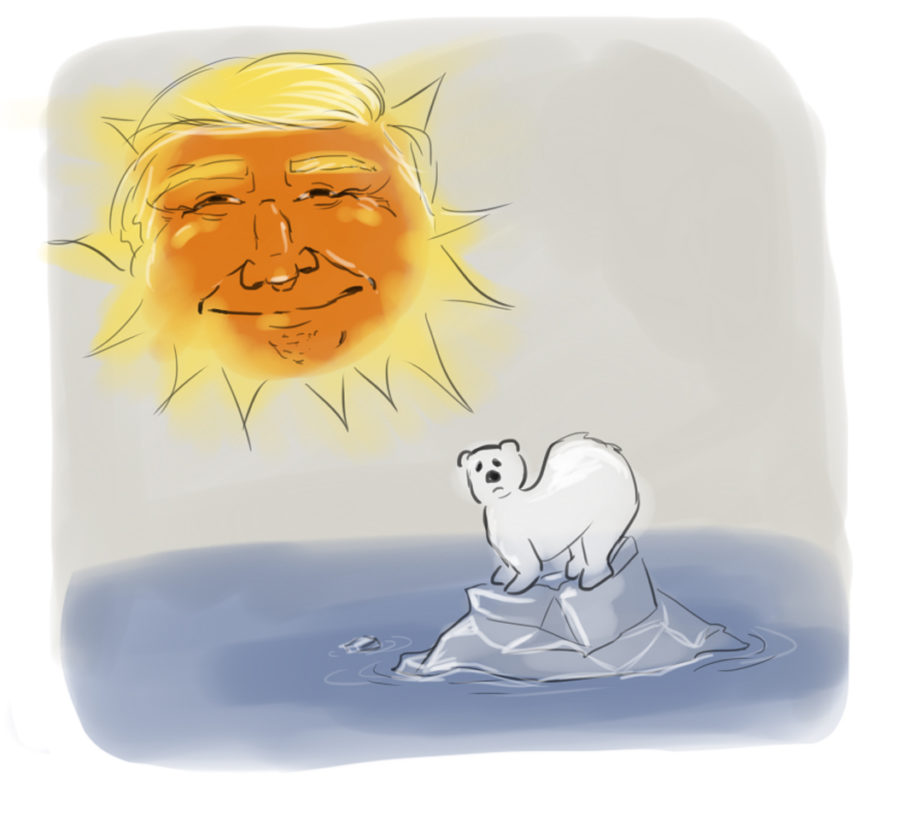President Donald Trump’s brightly colored receding hairline, black suit and white button-down shirt stood in sharp contrast to the dark-haired coal workers clad in golf shirts flanking him on either side.
The occasion was March 28 in Washington, D.C., during the signing of an executive order intended to roll back EPA energy emission restrictions. The president declared, “Historic steps to lift restrictions on American energy … will eliminate federal overreach [and] restore economic freedom.” The whole scene seemed an ironic reminder of just how in tune the president is to the “fellas” who constitute the American working class.
The order will “allow our companies and our workers to thrive, compete and succeed on a level playing field … For the first time in a long time, fellas,” the president added, smiling toward the men standing at the heels of his chair.
The problem with this executive order is that it does more to hinder the development of renewable energy than it does to support the working class population who have suffered from the collapse of the fossil fuel industry.
The focus of this executive order is to suspend a number of climate laws — specifically the Clean Power Plan, which the Obama administration introduced to reduce carbon pollution from power plants. The order has suspended the policy until further review, continuing Trump’s crusade to impair Obama’s presidential legacy, rather than create his own.
EPA head Scott Pruitt and Trump have worked for months to spin the policy as one that’s “pro-job and pro-environment” as Pruitt said in an address at the EPA on Feb. 21.
But the coal miners who quite literally backed Trump as he signed the executive order represent only about one-tenth of 1 percent of the American workforce. With fewer than 200,000 permanent jobs pertaining to the coal industry, the order affects a very small portion of the U.S. economy.
And even if this policy did extend the demand for coal in the United States, an increase in coal production would not necessarily correlate to an increase in coal-related jobs. Over the last few decades, power plants have increasingly relied on automated equipment for higher outputs at faster speeds.
From 1980 to 2015, the number of coal workers plummeted by 60 percent, despite an 8 percent increase in coal production. And a 2016 study by the International Institute for Sustainable Development anticipated that automation will eventually supplant 40 to 80 percent of coal miners.
The same study found that driverless technology has the potential for a 15 to 20 percent increase in output, a 10 to 15 percent decrease in fuel consumption and an 8 percent decrease in service fees. The coal industry must rely on automation, rather than people, if it wants to continue to compete with the continually growing oil and renewable industries.
Automation may still provide some opportunity for job production, but the jobs will be specialized and not likely available to Trump’s working-class supporters. This policy has the potential to create the kinds of jobs that would only increase the economic burden on the people the Clean Power Plan is said to hurt, while slowly severing the lifeline that future jobs in the renewable industry could provide them.
The environmental focus in the renewable energy industry is clearly difficult for Trump to maneuver, as he’s unfamiliar with the non-traditional business structure.
“We’ll be fine with the environment,” Trump said to clarify his political priorities in a 2015 interview with Chris Wallace. “We can leave a little bit, but you can’t destroy businesses.”
We can leave a little bit of the environment! A pro-environment policy, indeed.
While the order does not directly withdraw the United States from the Paris Agreement — a joint resolution within the UN Framework Convention on Climate Change to reduce emission outputs — it does make it nearly impossible for the United States to meet its own commitment to cut American emissions by nearly 26 percent of 2005 levels by 2025.
Should the United States fail to comply with the mission of the Paris Agreement, there’s a good chance other nations will fall short as well. This would cripple the treaty’s success, having the same effect as the Bush administration’s refusal to enter into the Kyoto Protocol — the Paris Agreement’s predecessor designed to reduce international carbon dioxide emissions — just 12 years ago.
The rollbacks on environmental regulations follow a 31 percent cut to the EPA, a department whose funding constitutes only .22 percent of the federal budget. Given the small role that the EPA’s operations play in the country’s overall budgeting, it’s possible Republicans made the cut simply to control what they saw as the agency’s threatening “totalitarian” tendencies. Or perhaps it was made because the Trump administration continues to neglect the reality and severity of the climate change crisis and can no longer be confronted by their own misgivings.
This is, afterall, the most troubling aspect of last Tuesday’s executive order: all the questions it leaves unanswered.
If the Clean Power Plan is repealed, the EPA must devise its own replacement. What will that plan look like? Where does this leave the United States with regard to the Paris Agreement? And, will this order even help create jobs in the fossil fuel industry? If it does create jobs, how will it do so? How many will it create? And what will be the effect?
As Trump might say, “Nobody really knows.”
Jaime primarily writes about social and environmental issues for The Pitt News.
Write to her at jrv28@pitt.edu.


